Neanderthal environmental bio-advantages, and their socio-cultural impact
Volcanic landscapes and their positive impact on human health (1/3)
by Amanda Laoupi
Extended research has shown that environmental stimuli triggered biomechanical and biochemical alterations in the human species since the early Palaeolithic times (Laoupi, 2011; Laoupi, 2016). One unique example is the fact that our remote ancestors chose repeatedly volcanic environments, where they survived, lived, reproduced and evolved. Other biogenetic alterations also helped Neanderthals to survive in harsh conditions. Moreover, caves with their ionized internal atmosphere, acoustics, biochemical composition and soothing impact were healing places for humans, places of initiation, education and mystic allegories (Laoupi, 2007).
Some of the most numerous and extensive finds of fossil and archaeological material relating to the earliest phases of human evolution (eg Rift Valley, Jordan Rift, S. Caucasus, Sangiran Dome in Indonesia) are no coincidence, indicating a relationship between distinctive, topographically complex volcanic landscapes (fault-bounded basins, uplifted terrain, ubiquitous volcanoes, lava fields) and water bodies that deserves closer investigation.
The dispersal of Hominines also followed along the same patterns. Springfed water sources provided potable water, adequate iodine and other micronutrients such as cobaltium and selenium, along with bedrocks and sediments containing iodine. The ideal spots to find big game in the Pleistocene were soils underlain or surrounded by volcanic sediments (the Massif Central, in France, being one of the prominent Palaeolithic examples).
Later on, during the last five millennia, the Neolithic era gives rise to five principal hearths of historical civilizations, more or less correlated with volcanic areas:
- The Mediterranean-Middle-East - Zagros & Aegean Sea recent faults, Miocene/Current Cyclades archipelago volcanicity
- India - Indus hollow fracture
- China Tancheng-Lujiang and Xingan-Taihang Earth's crust fractures zone and Quaternary major faults, Taihang mountains risings and quaternary cracks
- Mexico – volcanic Top-Plates, and (5) Peru - Andes Cordilleras volcanic High-Grounds.
Especially the Pleistocene interglacial and Holocene landscapes of France were extremely favourable to humans, with lush vegetation, rich fauna, fertile soils and abundant tool-fit materials. The most recent stage of full exploitation of these biotopes comes with the Neolithic, ca 5000 BC., through a gradual ecological/economic re-adaptation. All these volcanic sceneries seemed to enhance the pastoral/agricultural processes (Raynal & Daugas, 1984: 7 – 20; Daugas & Raynal, 1988; Guilaine, 1998).
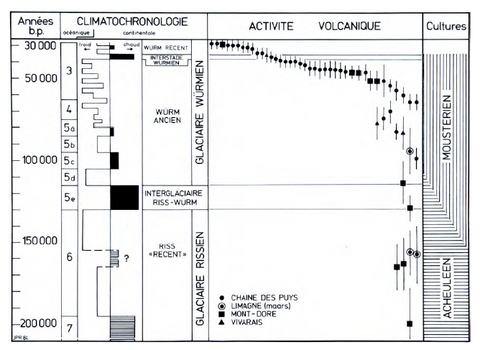
After Raynal & Daugas, 1984: p. 17, Table 2.
Climatic chronology, volcanic activity and human occupation in Massif Central, between 200.000 and 30.000 years BP. Note the reduced volcanic activity during Riss and first half of Wűrm Glacial in Basse-Auvergne. On the contrary, an intense volcanic activity took place during the end of the Lower Wűrm. Absolute dates from D. MIALLIER (1982) & G. GUERIN (1983). Climatochronologies from H. LAVILLE, J.P. RAYNAL & J.P. TEXIER (1984)
On the other hand, the volcanic earths were known since antiquity to have medical properties (Laoupi, 2006). The ‘flame of Hephaistos’ or his ‘red breath’ (characterized as purest flame) was a leitmotiv among the ancients (Orphic Hymn 66 to Hephaestus; Homer Iliad, II.426, IX.467, XVII.88 & XXIII.33 and Odyssey xiv.71; Hesiod Theogony, 864; Aristophanes Birds, 436; Quintus Smyrnaeus, 13.170,13. 367 & 4.160; Suidas, s.v. 'Hephaistos'). Although ancient writers mention it together with Keian, Cappadocian and Sinopic earths, all four being identified as red earths, Pliny’s comment makes the difference. This earth (terra lemnia, rubricata or sigillata) resembles cinnabar (35.14), it had a pleasant taste, too, while Galen (13.246b) adds that “it differs from miltos because it doesn’t leave a stain when handled”. The same writer, during his visit to Hephaestias, analyzes the myth of Hephaistos and his relationship with Lemnos, saying that “the mythical hill, also known as Mosychlos, appeared to be burnt due to its color and from the fact that nothing grows on it”. Belon, during his journey in the 16th cent., refers also to the yellow/white colors of the earth, equally explained by the presence of hydrothermally altered rocks. The ritual of its extraction highlights its peculiarity (Hall & Photos-Jones, 2008: 1034 - 1049). The god himself was characterized as an ‘aithaloeis theos’, meaning the sooty god (Suidas , s.v. 'Aithaloeis theos') and in Lemnos, Hephaestus was worshipped as a god of healing, his priests possessing antidotes to poisons. Later on, the priestesses of Artemis had the right to use this earth (Photos-Jones & Hall, 2011).
Not surprisingly, volcanic environments, even being highly risky, have a lot to offer to humans. The slopes of volcanoes and the surrounding regions are covered with rich, volcanic soil that gives lush vegetation and thriving ecosystems.
Volcanoes also create brand new islands. Over hundreds of thousands of years, these volcanoes breached the surface of the ocean /sea becoming inhabitable islands, and resting stops during long sea journeys. Unique species of plants and animals evolved into new forms on these islands, creating balanced ecosystems.
Another benefit of volcanos are the many precious gems as well as building materials that can only come from volcanoes. Opals and obsidian are produced in volcanoes. Volcanic eruptions produce pumice stones, which people have used to remove excess skin. Hardened volcanic ash, called tuff, makes a strong, lightweight building material.
Moreover, regions of volcanic activity are enormous sources of geothermal energy with its healing properties, which were appreciated thousands of years before the modern era. Hominids and humans instinctively weighed the negative impacts against the positive impacts and repeatedly chose to live under the shadows of volcanoes.
The physical traits of Obsidian (fire element) are associated with the relief of pain and its energies enhance vigor, strength, stamina, constancy, permanence, tenacity, courage and self-control; it is considered as the stone of entrepreneurs and inventors. It prevents the flow of negative energy, humans perceived obsidian as a stone of protection and honesty, bringing out the warrior spirit. In Chakra healing, Obsidian reflects the base chakra that controls our “grounding” to the Earth, being associated with all our survival instincts and self-preservation; it is also relating to the physical body, individuality, stability and security.
Chakra(< Sanskrit “wheel”) is like a vortex, a constantly revolving wheel of energy. These vortexes connect the subtle bodies and act as transducers for life-force energy. Chakras distribute the life force through the physical and subtle bodies. They are the source of physical, emotional, mental and spiritual energy. Traditionally, there are nine major chakras associated with the physical body, counting two above the head within the etheric field, which are not normally referred to. They are aligned with the spine and located in the base of the spine, the lower abdomen (sacral), the solar plexus, the heart, the throat, the centre of the forehead (third eye), and the crown of the head. When our chakras are blocked, or not in balance, the free flow of energy is impeded, leading to physical, emotional, mental or spiritual disease. When the chakras are unblocked and free-flowing, however, we enjoy optimum health. Each chakra is associated with specific colours and crystals and governs different aspects of human emotion and behaviour. Using crystals with the chakras can have a great healing effect.
So, Obsidian aids the digestion and detoxifies. It reduces arthritis pain, joint problems and cramps. Moreover, it brings clarity to the mind and clears up confusion, by dissolving emotional blockages and ancient traumas. It is worth mentioning that Obsidian is a very powerful stone, one which reminds us that birth and death are simultaneously and constantly present, one together with the other, always as one, an experience lived by our remote ancestors in volcanic landscapes, both fertile and deadly. This is a stone that has always been associated with guardian spirits that watch over us, and is connected to protection on all levels. Although most people are familiar with the regular black obsidian, there are several other types including:
Apache Tear, Blue, Blue/Green, Gold Sheen, Mahogany, Rainbow, Red, Silver Sheen and Snowflake. Obsidian can be found almost anywhere where there has been volcanic activity in the past, but not all the sources are currently being mined. Most mining is done in Armenia, Greece, Hungary, Iceland, Italy, Japan, Java, Kenya, Mexico, New Zealand, Scotland, Turkey, and United States (Arizona, California, Colorado, Hawaii, Idaho, Indiana, Montana, New Mexico, Oregon, Texas & Utah). Mayan Priests used scrying mirrors made of obsidian to foretell the future. They called the mirrors, “smoking mirrors”, as black Obsidian is a diviner's stone (Brennen, 1987; Stein, 1987; Gardner, 1988; Melody, 1995; Stein, 1996).
In parallel, vortices are high energy spots on the Earth, due to its Electromagnetic field. NASA research has proved that the human energy field is tuned in to certain ‘Earth Waves’. These ‘hot spots’ are linked by Ley lines (energy lines). Earth vortices are analogous to the chakras in the human body. Ley lines are alleged alignments of a number of places of geographical interest, such as ancient monuments and megaliths which are thought by some adherents of dowsing and New Age beliefs to have spiritual power. Plato recognized grids and their patterns, devising a theory that the Earth's basic structure evolved from simple geometric shapes to more complex ones. These shapes became known as platonic solids: cube (4), tetrahedron (3), octahedron (8), dodecahedron (12), and icosahedron (20). In the Timeaus, Plato associated each shape with one of the elements, Earth, Fire, Air, Ether, and Water. The Earth's energy grids, from the beginnings of its evolutionary course, have evolved through each of these shapes to what they are today. Each shape superimposed upon the other to create a kind of all encompassing energy field with the very basis of Earth holding it all together. Volcanic environments are high conductors of energy, symbolizing the female power of Earth which gives birth and death to its creatures (see: Laoupi, 2011, Tthe Obsidian Neolithic religion). In addition, some animals like geopathetic stress like the bees, the snakes and the cats. Thus it makes sense why ancient people connected them with the Underworld and otherworld characteristics (see also Laoupi 2017 on the symbolism of bees, snakes and felines).
These highly active geotectonic areas were also connected to sacred places of divination. A famous example is the Delphi Oracle (Central Greece). Recent studies have speculated that the prophetic powers of the Pythia at the Temple of Apollo were induced by hydrocarbon vapours, specifically ethylene, rising from bedrock fissures at the intersection of the E-W Delphi fault with the NNW-SSE Kerna fault, and producing neurotoxic effects, including trance and delirium. New surveys including gas flux from the soil, the gas in groundwater, and isotopic analyses of spring scales, provide the experimental confirmation of the gas release in the Delphi area (De Boer et al., 2001; Etiope et al, 2006).
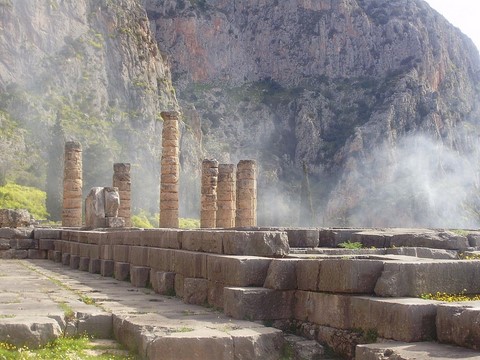
A Delphi magic mist. Image credit: Laslovarga (2009). CC BY-SA 3.0.
https://en.wikipedia.org/wiki/Pythia
The geothermal waters have medical properties too, as they benefited diseases of the skin and blood, nervous affections, rheumatism and kindred diseases, and the "various diseases of women". Scientists have proven that bathing in the lagoons has positive effects on rheumatics, psoriasis, acne, dermatitis and eczema, pimples, blackheads, whiteheads, blemishes, large pores and rosacea. Sulphur naturally occurs in volcanoes, surfacing upwards daily from underground steam vents and is also found in hot mineral springs. Natural Volcanic Sulphur is well documented in medicine for its anti-bacterial, anti-fungal, anti-inflammatory and natural
antiseptic properties which make it an excellent active ingredient.
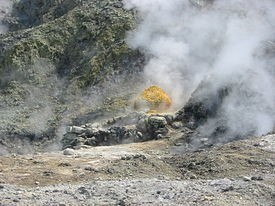
Campi Flegrei. Solfatara Crater, Italy.
Image credit: Donar Reiskoffer, 2003. CC BY-SA 3.0.
https://en.wikipedia.org/wiki/Phlegraean_Fields
The most crucial parameter, though, are the environmental stimuli that made our remote ancestors choose repeatedly the volcanic environments, where they survived, lived, reproduced and evolved. The geochemistry of such environments includes, among other valuable elements, the naturally occurring Halogens (fluorine, chlorine, bromine, iodine). Especially, chlorine, bromine and iodine are strongly enriched in the sea, while iodine and to a lesser extent bromine are further concentrated in the marine algae. Minerals, sediments, clays and bedrocks in igneous environments are rich in such elements, and are influenced by proximity to the sea.
Iodine and chlorine are essential elements for mammals and fluorine has been shown to have beneficial effects on bone and tooth formation. However, excess quantities of dietary fluorine can be harmful. It is possible, in view of its ubiquitous occurrence in the biosphere, that bromine has a hitherto unknown function in human and animal health (Fuge, 1988). Furthermore, apart from the degassing of bromine and iodine from volcanoes, volcanic landscapes contain a lot of other rare elements (lithium, rubidium, arsenic, boron, strontium, antimony, germanium, etc), iron, copper, zinc, and selenium, being brain selective minerals.
But no other species but man, including primates, exhibits symptoms of iodine deficiency. The inability of humans to conserve iodine seems to reflect the hominids’ way of life in highly active tectonic areas and shorelines, with a diet rich in iodine absorption (Brown-Grant, 1961; Venturi et al, 2000). In 2008, this ancestral antioxidant action of iodides has been experimentally confirmed by Kupper et al.
Since 700 million years ago, thyroxine is present in fibrous exoskeletal scleroproteins of the lowest invertebrates (Porifera and Anthozoa), without showing any hormonal action. When some primitive marine chordates started to emerge from the iodine-rich sea and transferred to iodine-deficient fresh water and finally to land, their diet became iodine deficient.
Therefore, during their progressive slow adaptation to terrestrial life, the primitive vertebrates learned to use the primitive thyroxine in order to transport antioxidant iodide into the cells, for a better adaptation of the organisms to the terrestrial environment (with consideration of fresh water, atmosphere, gravity, temperature and diet). Recent research has proven that, "Iodides have many non-endocrine biologic effects, including a role they play in the physiology of the inflammatory response. They improve the phagocytosis of bacteria by granulocytes and the ability of granulocytes to kill bacteria. They concentrate around tumors and granulomas in man and animals. They also move into areas of tissue injury” (Dobson, 1998; Stone, 1988).
The circumstances of human brain evolution are of central importance when accounting for human origins, yet they are still poorly understood, but they can be focused on three main points: (1) The human brain cannot develop normally without a reliable supply of several nutrients, notably docosahexaenoic acid (DHA), iodine and iron, (2) The human foetus has about 13 % of body weight as fat, a key form of energy insurance supporting brain development that is not found in other primates (survival of the fattest babies was the key to human brain evolution), and (3) The genome of humans and chimpanzees is <1 % different, a fact that shows differentiation in habitats during the last 5-6 million years of hominid evolution. Shellfish, fish and shore-based animals and plants are the richest dietary sources of the key nutrients needed by the brain. The consumption of most shore-based foods requires no specialized skills or tools, whether on the shores of lakes, marshes, rivers or the sea.
So, the presence of body fat in human babies appears to be the product of a long period of sedentary, shore-based existence by the line of hominids destined to become humans (Broadhurst et al, 2002 & 1998; Cunnane & Crawford, 2003; Cunnane, 2005 & 2006; Cunnane & Stewart, 2010). Consequently, some of the most numerous and extensive finds of fossil and archaeological material relating to the earliest phases of human evolution (eg Rift Valley, Jordan Rift, S. Caucasus, Sangiran Dome in Indonesia) are no coincidence, as they are indicating a relationship between distinctive, topographically complex volcanic landscapes (fault-bounded basins, uplifted terrain, ubiquitous volcanoes, lava fields) and water bodies, a coincidence which deserves closer investigation. The hominines' dispersal followed also the same patterns (King& Bailey, 2006).
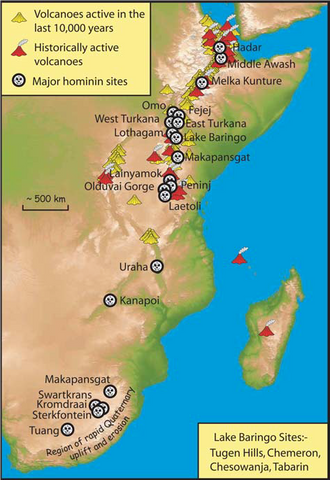
General indication of hominin sites in the African Rift and areas of volcanic activity.
After King & Bailey, 2006:267.
The same patterns seemed to exist during later times. Springfed water sources provided potable water, adequate iodine and other micronutrients as cobaltium and selenium, along with bedrocks & sediments containing iodine. The ideal spots to find big game in Pleistocene were soils underlain or surrounded by volcanic sediments (Haynes, 2002).
(1/3) To be continued
Dr AMANDA LAOUPI – Archaeologist/Environmentalist/Disaster Specialist
Coming soon:
- Environmental stress factors and Neanderthal DNA
- Humans in caves: Health advantages
NEW: The Eternal Embrace
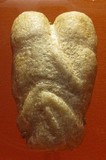
Read on-line
Cyprus salt lakes exonerate Peoples of the Sea from destroying Bronze Age civilizations
Toppling Rome's obelisks and aqueducts
Trevor Palmer's response to Gunnar Heinsohn
Jan Beaufort: Conspiracy or religious history?
Gunnar Heinsohn's answer to Trevor Palmer
G.H.: Vikings without towns, ports and sails...
Trevor Palmer challenges Gunnar Heinsohn
The 1st Millennium AD controversy
The exact dates of the deaths of Patroclus and Hector
Lybian rock-art erased by Jihadists
The tsunami that obliterated Doggerland
Miles below ground, live the creatures of the Deep
Navigation systems of migratory birds suffer from electromagnetic fields
G.H.: Charlemagne's correct place in history
The petroglyph sundial of Mount Bégo
Mount Bégo: an electrical mountain

